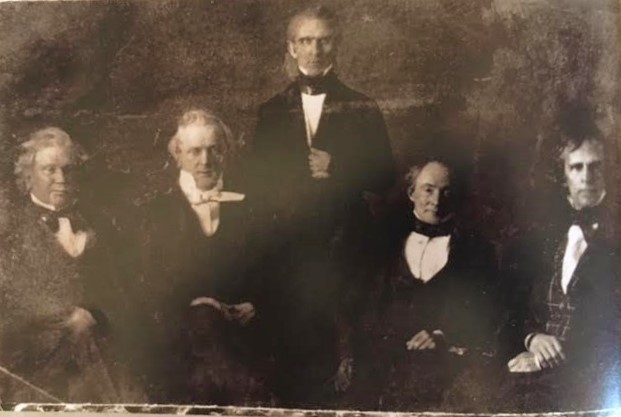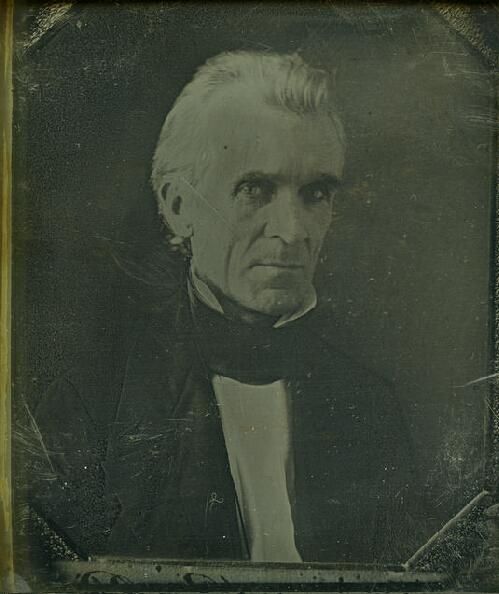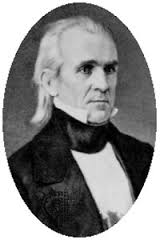Lightning Strikes…Twice
Fellow Romantics and Normal People,
In life there are happy little things that appeal universally to everyone – like getting the crunchy, brown corner piece of macaroni & cheese or firing-up your Netflix cue on a rainy day. And then there are more esoteric things that appeal to a small clutch of peculiarly curated humans (yours truly among them) that make our hearts soar and our dreams toggle from wishful thinking to sweet reality. The experience I’m about to describe definitely falls into the latter category. It was my “macaroni & cheese moment” for the eccentrically endowed.
I have an extravagant interest in presidential history, so you’d not find it surprising I’ve grown especially enamored of the few extant presidential daguerreotypes taken at the dawn of photography (1839-1849). I’ve breathlessly examined these precious early daguerreotypes like a sculptor minutely studies the contours of his model to understand the interior superstructure supporting the external surface. I’ve pored over these images with wistful reverence, ardently projecting myself into the static black and white scenes to animate and colorize them while dreaming of meeting the personalities and experiencing the tenor of their times. And in all the time I’ve been doing this there has only been a finite number of images to enliven because (to paraphrase Will Rogers reason on why it’s a good bet to buy land) “They ain’t makin’ anymore.”
I hope to convey to you that this event was my “Rosebud” moment in reverse. It was not the confluence of dispiriting rivers of regret so typical of routine misfortune. Rather it was the opposite of that – an unexpected moment when the fates conspire to bestow jaw-dropping joyousness in one unsuspecting glance. And all this just because I was poking around cyberspace and serendipitously discovered something that had been buried in history for 170 years. It made this not-so-little boy’s heart go pitter-patter, zing-zing and boom-boom-boom. I never knew a heart could be sound like a carnival ride. And to think this clangorous cardiac event was triggered by a grainy old picture of some forgotten president. Well it might be dismissed as some grainy old photo to you, but it was a revelation to me. It was a long-lost daguerreotype of my favorite president, James Knox Polk, taken near the creation of photography in 1847. That this previously unknown daguerreotype emerged at the genesis of photography rendered the experience of beholding it almost Biblical in nature. This unexpected gift from a momentary wormhole in antiquity jolted me into a historical heaven of profound visual satisfaction. And the kicker was, this historical lightning didn’t just strike once. It struck twice in the span of 5 years. IYHAYKICYH! (If you’re happy and you know it clap your hands)!
Born that Way
We’re born into these bodies with pre-loaded software dictating much of our future actions. It stands to reason that our infatuations seem to choose us more than we choose them. And although we share about 99% of our DNA with chimpanzees, the other 1% allows us to be the only animal on earth capable of identifying new car smell. Speaking of vehicles; the particular model I occupy came equipped with a prominent hood ornament (my nose – not the other thing) and a deep fascination with our early presidents. Many of our interests are just built-in things – like cruise control, but I got presidential fascination instead of air bags (although I’m told I can be kind of an air bag once I get bloviating).
Why do we have these deeply embedded, single-minded tendencies? Perhaps it’s a carryover from a past life, or, more likely, it’s because dear old mom had one too many Mimosas during the first trimester. But however these interests were generated they must be discharged or they’ll back up and cause problems. If you ignore he calling of your inner voice you might go astray and join a circus or maybe even become a Republican, which, if you think about it, is really the same thing right now.
As I’m sure you’ve discovered, this roundabout theory of what motivates us isn’t exactly watertight, but I’m sure the analogies are not lost on you. Some may resist their passions and become a mass of suppressed symptoms. Not me. I was compelled to act on my passions and was grateful they were mostly legal. I could not sublimate my cravings by earning merit badges, ladling soup to the homeless or reading MAD magazine. Ours is not to question why we have certain attractions. Ours is to play the cards as they’re dealt. Now I’m not saying I got a bad hand (white North American male is not bad for starters). I’m just saying it’s my hand and I have to deal with it. Maybe you have a penchant for hydroponic gardening, Pre-Colombian Art or model railroading. I get it. But to know thyself is to recognize yourself and I know I suffer from a somewhat uncommon and unaccountable disorder: Early Presidential Photographic Fascination Syndrome. And I’ve been drawn to early presidential history since I can remember.
More Specifically
Frenchman Louis Daguerre invented the first photographic process – his eponymously titled daguerreotype. After the French government agreed to provide a lifetime pension, Mr. (or is that Monsieur) Daguerre released the instructions for producing these images and they were brought to America in a packet ship in September of 1839. The advent of this process allowed us to faithfully and permanently represent images heretofore only speculated upon. We were dependent on artist interpretive renderings, biased descriptions or rampant imaginations reference whatever item was being discussed i.e., the Pyramids, Queen Victoria, landmarks, ships and buildings. Photography demystified the world and showed us ourselves in great clarity – perhaps a little too much clarity (warts and all). One wonders what the world would be like today if we had photographs of Jesus or Mohammed (bad example). How about a film clip of Jesus’s Sermon on the Mount? These speculations however go beyond the scope of this tale and serve only to playfully dimensionalize an already unfathomable world.
In my world there exists a bright line between the pre and post-photographic eras. The post-photographic world memorializes life in all its glory, mundanity and squalor. The pre-photographic era remains a speculative mystery shrouded in hoary myths, embellished representations and faulty interpretations. Photography exploded these myths and portrayed with great veracity the true forms of our predicament. Before photography many earthly things were an unverifiable, unknowable mystery. At least that’s how the advent of photography strikes me. I believe photography made our world a much smaller and more understandable place. And this photographic demising line I describe in such grandiose terms is the macro version of its collateral effects. Now here’s the micro version. That is; how photography affected (afflicted) one ardent soul (me) in the here and now.
Hello, my name is David Hardiman and I’m a Presidential Daguerreoholic.
So Here’s the Deal
My attraction to Presidential history (particular pre-Civil War Presidents) knows no bounds. As mentioned earlier, it’s a hunger that must be fed – and on a regular basis. And through my constant and methodical ferreting-out process I happened upon a startling discovery while engaged in some highly advanced sleuthing (if you consider Google searches “sleuthing”). I unearthed a historically significant photographic gem on par with Carter’s discovery of King Tut’s in tomb in 1922 or Marshall’s discovery of gold near Sutter’s Mill in 1848 or my discovery of the Beatles on Ed Sullivan in 1964 – that level of thunderbolt. What makes this photographic excavation doubly remarkable is that it was completely serendipitous and came on the heels of a similarly unprecedented photographic discovery in 2012 when I was made aware, quite by accident, of the recent emergence of a long-lost daguerreotype of our 11th President James Knox Polk and his cabinet taken in 1849. That first picture (of Polk and his cabinet) would be enough for one lifetime. So I’ll take a moment to describe its discovery as a table setter for the 2nd Polk discovery which prompts this entire story.
The First Lightning Strike
Boom goes the thunderclap. Every November 2nd I call John Holtzapple, curator of the Polk ancestral home in Columbia TN, to wish President Polk a happy birthday in absentia, and to discuss any Polk news that may have occurred in the previous year. As we’re over 150 years after Polk’s death there usually there isn’t much news. But in 2012 John told me of a new Polk photograph that had been unearthed. WIT (What in tarnation?)? Historical Photographic Detective Cliff Krainik – a Prometheus of long-lost daguerreotypes – had made a huge discovery. I got in touch with Mr. Krainik and he told me where to find this rare picture. And here in all its grainy glory is the previously unknown daguerreotype of President Polk and his cabinet I was alerted to in 2012:

left to right: Secretary of Navy John Mason (a fellow classmate at the University of North Carolina), future 15th President and then Secretary of State James Buchanan (note unbalanced face; near-sighted in one eye, farsighted in the other – he was a real duplicitous thorn in Polk’s side), James Knox Polk (standing, with the Napoleonic hand tucked into his coat), Secretary of the Treasury Robert Walker and Attorney General Isaac Toucey (nice vest). I don’t think anyone was in charge of hair and make-up for this shoot.
This daguerreotype of President Polk and his cabinet was taken on February 4, 1849 (we know the date from a Polk diary entry) in the waning days of his administration and about 4 months before his post-Presidential death from cholera in June. All posers are typically unsmiling since the daguerreotype process usually took a minute or two of motionless rigidity to properly affix the image onto the silver-coated copper plate – think of it as the Mannequin Challenge of 1849.
We see President Polk at the center of this portrait soberly presiding over his cabinet. Such a doggedly determined man. When he entered office he vowed to serve only one term and he worked himself to death; dying three months after leaving office. His brown hair had toggled from lush brown to brittle gray and his health was broken. He did however achieve his 4 stated goals:
- To acquire California. By warring against Mexico when negotiations failed.
- To settle the Oregon border question. Remember 54′ 40′ or fight? Well that latitude is up near southern Alaska. The border was actually settled with Great Britain at a less belligerent 49th parallel and without a fight.
- To create an independent treasury. Done – no more state bank repositories that could fail.
- To lower the tariff. Done – not exactly NAFTA, but an improvement nonetheless
The provenance of this particular breathtaking window on the presidency is byzantine. Suffice to say it was unknowingly purchased in a bulk crate of old Brady-Handy photos at an estate sale in Falls Church, VA by Mr. Krainik and quickly recognized as the epically historic treasure it was. In actuality the above picture is a photo of a photo of the original daguerreotype which is lost to posterity. However, the discovery of this photographic manna from heaven is a visual portal on an event 163 years in the past. Its new found existence goes a long way in feeding the hunger of the daguerreotypic-deprived areas of my brain. I suppose in some sense this ecstasy is similar to the sweet release a junkie feels shortly after his fix. Anyway the picture’s appeal to me was something I felt acutely. I reveled in the joy of poring over the colors, contours and composition of this picture longer than I ever ogled any Playboy centerfold. This daguerreotype was found gold and I relished it with prodigious avidity. And that should’ve been enough for one lifetime and the end to this gratifying episode. However…
Lightning Strikes Again
As if the previous example of stumbling upon found treasure isn’t enough to satiate one’s historical lust; unbelievably a second instance occurred. I was just going about my business recently (I’m prevented from divulging just what my business is due to provisions in the federal Witness Protection Program), when I came across yet another unknown Polk daguerreotype. Really? Yes – really.
A little background is in order here to more fully convey the feelings prevalent when I made this jaw-dropping discovery. A supernova of sentiments, a tsunami of tstimulation overwhelmed me when I first espied this landmark daguerreotype. Bear in mind I was intimately familiar with Polk’s 5 known photographs. I had studied them for hours until their pixels were burned into my retinal screen. I know this narrow interest is represents my little corner of the universe, but since it’s the corner I occupy it, sometimes becomes my entire universe. And I’m damn happy about it. It’s a healthy enough passion serving to titillate curiosity. Just be glad I’m not a Star Wars nerd or a Lord of the Rings enthusiast otherwise this would be a very predictable little essay swollen with goofy, opinionated stuff about goofy, make-believe characters. No offense to my fellow romantics, but my nerdy nirvana resides in the real world of dusty old photographs and stoic old white guys; thank you very much. My Holy Grails are rooted in reality; if that’s any indicator of legitimacy.
Equivocations and justifications aside, on this particular momentous day I was productively engaged in some highly advanced internet excavating (if you consider Google searches “excavating”) when I unearthed another historically significant photographic gem. I had taken an unintended turn (a double-click actually) down an offshoot of a historical image search and found myself burrowed into a Pinterest rabbit hole I’d usually never visit if I wasn’t so lax in my surfing. But this time my unstructured cyber-meandering paid off. Because there appeared before me a revelation. I was eyeball to eyeball with a photographic relic that detonated before me like Krakatoa. I was in the presence of a previously unseen and unpublicized daguerreotype of James Knox Polk our 11th President?
These things don’t grow on trees folks, so when it presented itself to me I was absolutely nonplussed – and I don’t even know what nonplussed means; that’s how flummoxed I was with the kind of “crazy” you get from having dreams fulfilled. Was this really happening? Oh, heart be still. But it couldn’t be still. This not-so-little boy’s heart began pounding again. First with the pitter-patter, then with the zing-zing and finally with the boom-boom-boom. I was forced to cover my ears it was so noisy, but since the sounds were coming from the inside, covering my ears could hardly muffle my resounding joy. Oh boy. Oh boy.
Cue the Sgt. Pepper theme: ♫So may I introduce to you, the act you’ve known for all these years♫ And now for the first time anywhere, here he is, President Polk ~ Mr. January 1847:

Our 11th President James Knox Polk in 1847. Love this man. A bromance for the ages – he had me at “54°40′ or fight.” It’s as if he knew he’d be gazing into my eyes from a distance of 170 years.
James Knox Polk Centerfold Bio
James enjoys governing, church-going and empire-building. In his spare time he likes watching a roaring fire.
Turn-offs: People with hidden agendas, Whigs
Turn-ons: Diligence, his kittenish wife Sarah
Birthplace: His mother’s lap (which was then located in Pine Creek, NC)
Birthdate: November 2, 1795 AD. Same as Daniel Boone and David Schwimmer
Motto: “I enjoy persevering.”
Influences: Andrew Jackson, Worker Bees and Soldier Ants
Favorite Food: Whatever is placed before me
Religion: The one with the English speaking God
Pitter-patter, zing-zing, boom, boom, boom.
Gosh, gee willikers and holy mackerel…I guess lightning can strike twice.
Note to the Fates: I know it would be asking a lot, but have you thought about lightning striking three times?


